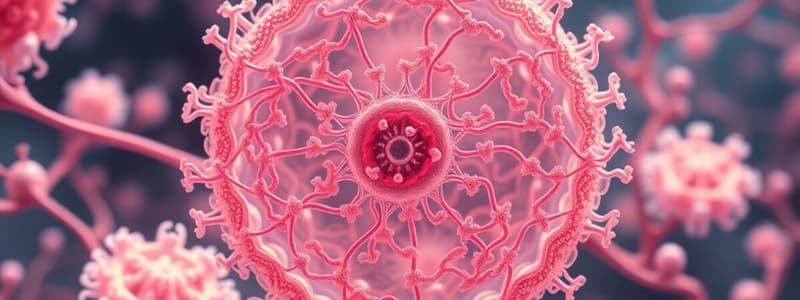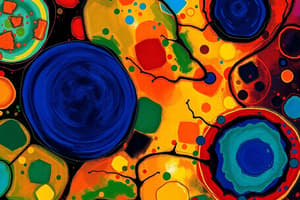Podcast
Questions and Answers
What is one of the main benefits of embryonic stem cells (ES cells)?
What is one of the main benefits of embryonic stem cells (ES cells)?
- They can differentiate into all three germ layers. (correct)
- They cannot proliferate indefinitely.
- They are obtained without ethical concerns.
- They have no potential for cell therapy.
Embryonic stem cells can only be derived from adult tissues.
Embryonic stem cells can only be derived from adult tissues.
False (B)
What procedure can be used to produce ES cells from the patient's own cells?
What procedure can be used to produce ES cells from the patient's own cells?
Somatic cell nuclear transfer (SCNT)
ES cells are crucial for the in vitro study of __________ processes which cannot be assessed otherwise.
ES cells are crucial for the in vitro study of __________ processes which cannot be assessed otherwise.
Match the following concepts related to ES cells with their corresponding descriptions:
Match the following concepts related to ES cells with their corresponding descriptions:
Who received the Nobel Prize in Physiology or Medicine in 2012 for discovering that mature cells can be reprogrammed to become pluripotent?
Who received the Nobel Prize in Physiology or Medicine in 2012 for discovering that mature cells can be reprogrammed to become pluripotent?
Induced Pluripotent Stem Cells (iPS cells) can only be generated from embryonic stem cells.
Induced Pluripotent Stem Cells (iPS cells) can only be generated from embryonic stem cells.
What significant contribution did Shinya Yamanaka make in 2006 regarding somatic cells?
What significant contribution did Shinya Yamanaka make in 2006 regarding somatic cells?
Somatic cell nuclear transfer (SCNT) is a technique associated with the cloning of __________.
Somatic cell nuclear transfer (SCNT) is a technique associated with the cloning of __________.
Match the following researchers with their contributions to stem cell research:
Match the following researchers with their contributions to stem cell research:
What is a key advantage of induced pluripotent stem cells (iPS cells) over embryonic stem cells?
What is a key advantage of induced pluripotent stem cells (iPS cells) over embryonic stem cells?
List two types of somatic cells that can be used to generate iPS cells.
List two types of somatic cells that can be used to generate iPS cells.
One of the benefits of iPS cells is that there are no ethical issues involved in their use.
One of the benefits of iPS cells is that there are no ethical issues involved in their use.
Which of the following is NOT included in the iPSC quality control checklist?
Which of the following is NOT included in the iPSC quality control checklist?
The stem cell-based therapy for Parkinson's Disease is called STEM-PD.
The stem cell-based therapy for Parkinson's Disease is called STEM-PD.
What primary cells were used in the pioneering procedure for Parkinson's Disease treatment?
What primary cells were used in the pioneering procedure for Parkinson's Disease treatment?
One method discussed for efficiently delivering cells is ______.
One method discussed for efficiently delivering cells is ______.
Match the methods of delivering cells to their descriptions:
Match the methods of delivering cells to their descriptions:
What is a potential advantage of using cord blood as a source of stem cells?
What is a potential advantage of using cord blood as a source of stem cells?
Mesenchymal stem cells (MSCs) have significant diversity in how they are described and manufactured.
Mesenchymal stem cells (MSCs) have significant diversity in how they are described and manufactured.
What is one current application of mesenchymal stem cells in clinical trials?
What is one current application of mesenchymal stem cells in clinical trials?
Cord blood contains both mesenchymal and __________ stem cells.
Cord blood contains both mesenchymal and __________ stem cells.
Match the types of stem cells with their characteristics:
Match the types of stem cells with their characteristics:
Which of the following is NOT a disadvantage of cord blood?
Which of the following is NOT a disadvantage of cord blood?
Current MSC clinical trials do not utilize their anti-inflammatory properties.
Current MSC clinical trials do not utilize their anti-inflammatory properties.
What is one challenge that needs to be addressed when taking stem cell therapies to the clinic?
What is one challenge that needs to be addressed when taking stem cell therapies to the clinic?
What is a known risk associated with induced pluripotent stem cells (iPSCs)?
What is a known risk associated with induced pluripotent stem cells (iPSCs)?
Multipotent stem cells are specific to specific tissues.
Multipotent stem cells are specific to specific tissues.
Who performed the first successful stem cell transplant?
Who performed the first successful stem cell transplant?
IPSC-derived retinal pigment epithelium (RPE) cells required patients to wait over _____ months for surgery.
IPSC-derived retinal pigment epithelium (RPE) cells required patients to wait over _____ months for surgery.
Match the type of stem cell with its characteristic:
Match the type of stem cell with its characteristic:
What is a major challenge of personalized medicine using iPSCs?
What is a major challenge of personalized medicine using iPSCs?
The Graft versus Leukemia (GvL) effect occurs in allogeneic HSC transplantation.
The Graft versus Leukemia (GvL) effect occurs in allogeneic HSC transplantation.
What is the significance of hematopoietic stem cells in transplantation?
What is the significance of hematopoietic stem cells in transplantation?
Which of the following diseases have been targeted by iPSC-derived cell therapies?
Which of the following diseases have been targeted by iPSC-derived cell therapies?
Pluripotent stem cells can give rise to neural stem cells.
Pluripotent stem cells can give rise to neural stem cells.
How many clinical trials involving iPSC-derived cell therapy are currently registered?
How many clinical trials involving iPSC-derived cell therapy are currently registered?
The trial plans to enroll a total of _____ patients for transplantation, starting with patients from Sweden.
The trial plans to enroll a total of _____ patients for transplantation, starting with patients from Sweden.
Match the following terms related to stem cells with their descriptions:
Match the following terms related to stem cells with their descriptions:
ESCs and iPSCs are equivalent for transplantations as part of stem cell therapies.
ESCs and iPSCs are equivalent for transplantations as part of stem cell therapies.
What is a current limitation of stem cell therapies?
What is a current limitation of stem cell therapies?
Induced pluripotent stem cells pose no concern of immune rejection.
Induced pluripotent stem cells pose no concern of immune rejection.
Flashcards
What are embryonic stem cells (ES cells)?
What are embryonic stem cells (ES cells)?
Embryonic stem cells (ES cells) are pluripotent cells that can differentiate into any cell type in the body.
What is the key characteristic of ES cells?
What is the key characteristic of ES cells?
ES cells possess the unique ability to multiply indefinitely while preserving their pluripotent nature.
What can ES cells be used for?
What can ES cells be used for?
ES cells can be used to create various cell types in the lab, aiding in understanding human development. Examples include neurons, blood cells, heart cells, and liver cells.
What is a major ethical concern regarding ES cells?
What is a major ethical concern regarding ES cells?
Signup and view all the flashcards
What is a biological challenge with transplanting ES cells?
What is a biological challenge with transplanting ES cells?
Signup and view all the flashcards
What is Somatic Cell Nuclear Transfer (SCNT)?
What is Somatic Cell Nuclear Transfer (SCNT)?
Signup and view all the flashcards
Why is Dolly the sheep significant?
Why is Dolly the sheep significant?
Signup and view all the flashcards
What is therapeutic cloning?
What is therapeutic cloning?
Signup and view all the flashcards
What are induced pluripotent stem cells (iPS cells)?
What are induced pluripotent stem cells (iPS cells)?
Signup and view all the flashcards
Who discovered iPS cells and when?
Who discovered iPS cells and when?
Signup and view all the flashcards
What are the advantages of iPS cells over ES cells?
What are the advantages of iPS cells over ES cells?
Signup and view all the flashcards
What are some potential applications of iPS cells?
What are some potential applications of iPS cells?
Signup and view all the flashcards
What is the future of iPS cell research?
What is the future of iPS cell research?
Signup and view all the flashcards
What is STR analysis for iPSCs?
What is STR analysis for iPSCs?
Signup and view all the flashcards
Why is karyotyping important for iPSCs?
Why is karyotyping important for iPSCs?
Signup and view all the flashcards
Why is viral testing necessary for iPSCs?
Why is viral testing necessary for iPSCs?
Signup and view all the flashcards
What are the challenges in cell delivery for iPSCs?
What are the challenges in cell delivery for iPSCs?
Signup and view all the flashcards
How does transdifferentiation circumvent the use of iPSCs?
How does transdifferentiation circumvent the use of iPSCs?
Signup and view all the flashcards
What are induced pluripotent stem cells (iPSCs)?
What are induced pluripotent stem cells (iPSCs)?
Signup and view all the flashcards
What are mesenchymal stem cells (MSCs)?
What are mesenchymal stem cells (MSCs)?
Signup and view all the flashcards
What are the key properties of MSCs?
What are the key properties of MSCs?
Signup and view all the flashcards
What is a limitation of iPSCs related to differentiation?
What is a limitation of iPSCs related to differentiation?
Signup and view all the flashcards
What is a limitation of iPSCs related to genomic and epigenetic alterations?
What is a limitation of iPSCs related to genomic and epigenetic alterations?
Signup and view all the flashcards
What is a key limitation of allogeneic MSCs?
What is a key limitation of allogeneic MSCs?
Signup and view all the flashcards
What are hematopoietic stem cells (HSCs)?
What are hematopoietic stem cells (HSCs)?
Signup and view all the flashcards
How are MSCs currently being used in clinical trials?
How are MSCs currently being used in clinical trials?
Signup and view all the flashcards
What is a major application of HSCs?
What is a major application of HSCs?
Signup and view all the flashcards
What is a potential source of stem cells?
What is a potential source of stem cells?
Signup and view all the flashcards
What are the advantages of using cord blood as a source of stem cells?
What are the advantages of using cord blood as a source of stem cells?
Signup and view all the flashcards
Which type of stem cells are most widely transplanted?
Which type of stem cells are most widely transplanted?
Signup and view all the flashcards
What is a major challenge of HSC transplantation?
What is a major challenge of HSC transplantation?
Signup and view all the flashcards
What are the disadvantages of using cord blood as a source of stem cells?
What are the disadvantages of using cord blood as a source of stem cells?
Signup and view all the flashcards
What are mesenchymal stem cells (MSCs)?
What are mesenchymal stem cells (MSCs)?
Signup and view all the flashcards
How can we overcome the scarcity of hematopoietic stem cells (HSCs)?
How can we overcome the scarcity of hematopoietic stem cells (HSCs)?
Signup and view all the flashcards
What are stem cells?
What are stem cells?
Signup and view all the flashcards
What are the classifications of stem cells?
What are the classifications of stem cells?
Signup and view all the flashcards
How can stem cells be used therapeutically?
How can stem cells be used therapeutically?
Signup and view all the flashcards
What are the limitations of stem cell therapies?
What are the limitations of stem cell therapies?
Signup and view all the flashcards
Pluripotent stem cells can give rise to neural stem cells.
Pluripotent stem cells can give rise to neural stem cells.
Signup and view all the flashcards
ESCs and iPSCs are equivalent for transplantations.
ESCs and iPSCs are equivalent for transplantations.
Signup and view all the flashcards
Umbilical cord blood derived stem cells can be used directly for clinical applications.
Umbilical cord blood derived stem cells can be used directly for clinical applications.
Signup and view all the flashcards
Induced pluripotent stem cells pose no concern of immune rejection.
Induced pluripotent stem cells pose no concern of immune rejection.
Signup and view all the flashcards
Study Notes
Learning Outcomes
- Define stem cells
- Classify different stem cell types
- Describe therapeutic use of stem cells
- Discuss current limitations of stem cell therapies
Lecture Overview: Part 1
- What are stem cells?
- Stem cell classification
- Pluripotent stem cells (ES cells and iPS cells)
- Multipotent stem cells
Lecture Overview: Part 2
- Translation to the clinic: several considerations
- Current applications of Stem Cell Therapies
Stem Cell Therapy: Regenerative Medicine
- Why? Organ shortage, donor incompatibility
- How? Repair tissues/organs, replacing cells
- Which sources? Isolated or induced stem cells
- Data: 103,223 people on the US national transplant waiting list (representative data)
What are Stem Cells?
- Stem cells have two defining qualities:
- Self-renewal
- Differentiation into specialized mature cells
- A diagram showing the differentiation of hematopoietic stem cells (HSCs) is included
What is the Origin of Stem Cells?
- Stem cells develop from a fertilized egg
- Stages shown: fertilized oocyte, morula, blastula, gastrula, embryo
- Different types of stem cells are shown: totipotent, pluripotent, multipotent
Stem Cell Classification
- Totipotent: Can give rise to an entire organism (e.g., zygote)
- Pluripotent: Can give rise to all three germ layers (mesoderm, endoderm, ectoderm)
- Multipotent: Can give rise to a limited number of cell types
Embryonic Stem Cells (ES Cells)
- Murine ES cell lines established in 1981
- Human ES cell lines derived in 1998
- Can be isolated from excess IVF eggs
ES Cells and Their Potential
- Can proliferate indefinitely, maintaining pluripotency
- Give rise to all three germ layers: neurons, blood cells, cardiomyocytes, liver cells
- Crucial for studying developmental processes
- Useful for modeling diseases (e.g., genetic diseases, etc.)
- Have significant potential for cell therapy
Limitations of ES Cells
- Ethical concerns: human blastocysts are sacrificed
- Allogeneic transplantation: immune rejection due to HLA haplotype mismatch
- Steps to circumvent immune rejection:
- Biobanking HLA-typed cell lines
- Somatic cell nuclear transfer (SCNT)
- Figures and data related to these considerations are presented
Somatic Cell Nuclear Transfer (SCNT)
- A technique to produce ES cells from a patient's own cells
- Diagrams are used to explain the process
- The Nobel Prize in Physiology or Medicine 2012 was awarded for this discovery
Therapeutic Cloning
- Using SCNT to produce ES cells for a patient's own use
- Diagram illustrating the process
Induced Pluripotent Stem Cells (iPS Cells)
- Fully differentiated somatic cells reprogrammed into pluripotent stem cells (2006)
- Reprogramming involves introducing specific genes
- Significant advantage because no embryos/ethical issues
- iPS cells possess many advantages similar to ES cells
- iPSC can be made easily, and maintained in storage
iPSCs and their Potential
- Overcome ethical concerns of ES cells
- Viable alternative for cell therapies
- Versatile for various somatic cell types (blood, keratinocytes, fibroblasts)
Limitations of iPSCs
- Risk of incomplete differentiation
- Genomic/epigenetic alterations in iPSC-derived cells
- Tumorigenicity due to incomplete silencing of oncogenic factors (e.g., Myc, Klf4)
- Personalized medicine may not be realistic
- Financial and time limitations can be significant
Multipotent Stem Cells
- More tissue-specific
- Harder to access and isolate
- Locations of adult stem cells shown in diagram
Hematopoietic Stem Cells (HSCs)
- Most widely transplanted stem cells in therapies
- HSCs reside in the bone marrow and replenish the hematopoietic system
- History of HSC transplantation: post-WWII, first transplant in 1956
- Considerations: GvHD, conditioning regimens, sources (BM, MPB, UCB)
- Allogeneic vs. autologous transplantation
- Indications for HSC transplantation: illustrated with a table categorizing malignancies and non-malignant disorders
Mesenchymal Stem Cells (MSCs)
- MSCs can differentiate in vitro into osteocytes, chondrocytes, and adipocytes
- Markers for MSCs
- Wide use in clinical trials (types and regions illustrated in diagram)
- Anti-inflammatory properties, tissue repair
- Short-term existence: possible allogeneic safety
- Immune suppression properties
How to Overcome the Scarcity of Stem Cells
- Extracting from alternate sources (e.g., umbilical cord blood)
- Expanding hematopoietic stem cells in vitro for increased yield
- Different methods for expanding cells shown in diagram
How to Design Protocols to Obtain Cells of Interest from Stem Cells?
- cGMP-compliant protocol
- Complete differentiation of all pluripotent stem cells
- Ensuring the specific cells of interest are obtained and tested for functionality
How to Ensure the Safety of Material to be Transplanted?
- Risks: Teratomas, insertional mutagenesis
- Important quality control checklist considerations
- Genomic integrity testing
How to Efficiently Deliver the Cells?
- Bioengineering considerations (biomaterials, injectable hydrogels, cell sheets)
- Other delivery methods discussed (organoid development, specific example of Parkinson's Disease therapy)
Blood Formation During Development
- Stages and locations of blood cell development
- Diagram shows the waves and locations of hematopoietic development in an embryo
Translation to the Clinic
- Overcoming stem cell scarcity
- Safe and efficient protocols for obtaining specific cells
- How stem-cells are safely delivered for transplantation and integration into patients
Parkinson's Disease
- Use of stem cells in the clinic for Parkinson's disease
- Clinical trial for Parkinsons disease
- Pioneering work of A. Björklund & O. Lindvall
iPSC-Derived Cell Therapy Trials
- Recent clinical trials using iPSC-derived cell therapy
- Diseases Targeted by iPSC therapies
Studying That Suits You
Use AI to generate personalized quizzes and flashcards to suit your learning preferences.




